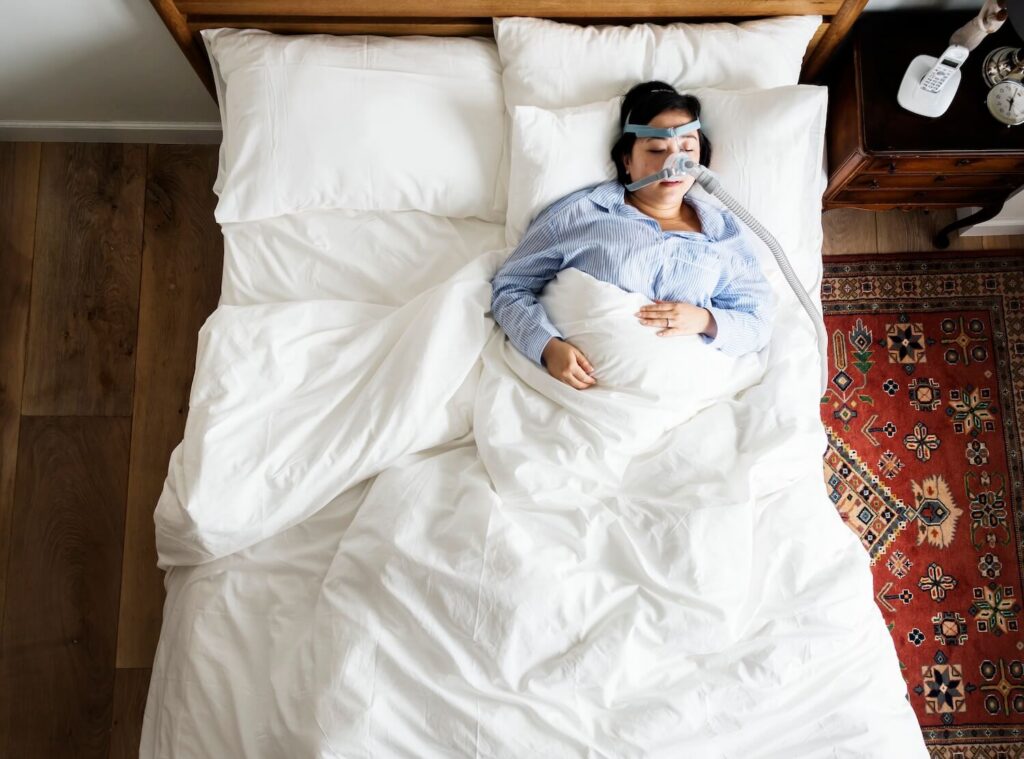Imagine lying down after a long day, hoping for a good night’s rest, only to wake up feeling even more exhausted than when you went to bed. You may even have a partner who constantly complains about your snoring, or maybe you catch yourself waking up in the middle of the night, gasping for air. If any of this sounds familiar, you may be one of the millions of people suffering from sleep apnea—a potentially dangerous and often undiagnosed condition that can significantly affect your overall health.
Sleep apnea is more than just a nuisance. It’s a serious medical condition that can disrupt your sleep patterns, harm your physical health, and reduce your quality of life. Fortunately, there are many effective treatments available to manage the condition and help you achieve silent, restful nights. But how do you choose the right treatment for your needs?
This article will explore everything you need to know about sleep apnea and its various treatment options, helping you make an informed decision about the best path toward a better night’s sleep.
1. What Is Sleep Apnea?
Sleep apnea is a disorder characterized by repeated interruptions in breathing during sleep. These interruptions, or “apneas,” can last for a few seconds to a minute and may occur several times an hour, affecting your ability to get restorative sleep. The condition is commonly divided into three types:
- Obstructive Sleep Apnea (OSA): The most common form, OSA occurs when the muscles in your throat relax too much during sleep, causing a temporary blockage of the airway. This blockage prevents air from flowing freely into your lungs, leading to pauses in breathing.
- Central Sleep Apnea: Unlike OSA, central sleep apnea occurs when your brain fails to send the proper signals to the muscles that control breathing. As a result, your breathing temporarily stops during sleep despite no physical blockage of the airway.
- Complex Sleep Apnea Syndrome (Mixed Sleep Apnea): This type is a combination of both obstructive and central sleep apnea and can be more challenging to treat due to its complexity.
Each type of sleep apnea presents its own unique challenges, but regardless of the type, untreated sleep apnea can lead to a host of other serious health issues. In the following sections, we’ll dive into these issues and explore the various treatment options available.
2. The Consequences of Untreated Sleep Apnea
It’s easy to dismiss sleep apnea as a minor inconvenience, but the truth is that untreated sleep apnea can have far-reaching consequences for your health and well-being. If left unmanaged, sleep apnea can increase your risk for a variety of health problems, including:
- Cardiovascular Issues: One of the most serious risks associated with sleep apnea is its effect on the heart. Repeated oxygen deprivation during sleep places strain on the cardiovascular system, leading to high blood pressure (hypertension), irregular heart rhythms (arrhythmias), heart failure, and even an increased risk of stroke and heart attack.
- Daytime Fatigue and Cognitive Impairment: Chronic sleep deprivation caused by sleep apnea leads to daytime fatigue, irritability, and poor concentration. It can also impair memory and cognitive function, making it difficult to perform everyday tasks and negatively impacting your overall productivity.
- Mood Disorders: Sleep apnea has been linked to mental health issues such as depression and anxiety. The constant disruption of your sleep cycle, combined with the physical stress on the body, can lead to mood swings, emotional instability, and an increased risk of developing mental health conditions.
- Diabetes: Sleep apnea can worsen insulin resistance, a key factor in the development of type 2 diabetes. Research has shown that people with untreated sleep apnea are at a higher risk of developing this chronic condition.
- Increased Risk of Accidents: The combination of fatigue and reduced mental clarity makes those with untreated sleep apnea more prone to accidents. Whether driving, operating machinery, or simply moving about during the day, sleep apnea-related drowsiness can impair reaction times and decision-making.
Given these serious health risks, it’s essential to seek a proper diagnosis and treatment plan as soon as possible to avoid the long-term consequences of untreated sleep apnea.
3. How to Diagnose Sleep Apnea
If you suspect that you might have sleep apnea, the first step is to consult a healthcare professional. A thorough evaluation is necessary to determine whether you have the condition and what type of sleep apnea you may have.
Sleep Apnea Diagnosis typically involves two main methods:
- Sleep Study (Polysomnography): A polysomnography, or sleep study, is considered the gold standard for diagnosing sleep apnea. It is usually conducted in a specialized sleep clinic or lab, where your brain activity, heart rate, breathing patterns, and muscle movements are monitored while you sleep. The study provides detailed information about the frequency and severity of your apneas, helping doctors determine the appropriate treatment.
- Home Sleep Apnea Test (HSAT): In some cases, a home sleep apnea test may be used as a more convenient and cost-effective option. This test allows patients to monitor their sleep patterns at home using a small, portable device that tracks airflow, blood oxygen levels, and respiratory effort. While HSATs are effective for diagnosing moderate to severe obstructive sleep apnea, they may not provide as comprehensive results as a full sleep study.
Once diagnosed, the next step is determining the severity of your sleep apnea and identifying the best treatment option based on your individual needs.
4. Treatment Options for Sleep Apnea
Once diagnosed, there are several treatment options available to help manage sleep apnea, ranging from lifestyle changes to more advanced medical interventions. The treatment plan will depend on the severity of your condition, your specific type of sleep apnea, and your overall health. Here are the most common treatment options:
Lifestyle Changes
For mild cases of sleep apnea or as a complementary treatment to other therapies, lifestyle changes can have a significant impact on managing the condition. Some of the most effective lifestyle changes include:
- Weight Loss: Excess weight, particularly around the neck area, can increase the likelihood of airway obstruction during sleep. Losing weight can help reduce or even eliminate symptoms of sleep apnea.
- Positional Therapy: Many people with sleep apnea experience it only when lying on their back. Sleeping on your side can alleviate symptoms, and special pillows or devices designed to encourage side-sleeping can be helpful.
- Avoiding Alcohol and Sedatives: Alcohol, sedatives, and tranquilizers relax the muscles in the throat, which can worsen the obstruction of the airway. Limiting or avoiding these substances, especially before bedtime, can help manage sleep apnea.
- Smoking Cessation: Smoking increases inflammation and fluid retention in the upper airway, exacerbating sleep apnea symptoms. Quitting smoking can improve breathing during sleep.
Continuous Positive Airway Pressure (CPAP) Therapy
For moderate to severe obstructive sleep apnea, the most common and effective treatment is Continuous Positive Airway Pressure (CPAP) therapy. A CPAP machine uses a mask that fits over your nose or mouth, which delivers a constant flow of air to keep your airway open while you sleep.
- How It Works: The machine works by blowing air at a steady pressure through a hose connected to a mask that you wear while sleeping. This continuous airflow prevents your airway from collapsing and helps you breathe normally throughout the night.
- Benefits: CPAP therapy is highly effective in reducing apneas, improving sleep quality, and minimizing the health risks associated with untreated sleep apnea. It also helps reduce snoring and the associated social disruptions.
- Challenges: Many users initially struggle with the discomfort of wearing a mask or keeping it on all night. CPAP therapy requires consistent use, and failure to adhere to it can limit its effectiveness.
Bilevel Positive Airway Pressure (BiPAP)
For individuals who have central sleep apnea or find CPAP uncomfortable, BiPAP may be a better option. A BiPAP machine provides two levels of air pressure: a higher pressure when you inhale and a lower pressure when you exhale.
- Benefits: BiPAP is often better tolerated by people who have trouble exhaling against the constant pressure of a CPAP machine. It is also an effective treatment for people with central sleep apnea.
Mandibular Advancement Devices (Oral Appliances)
For those with mild to moderate obstructive sleep apnea, an oral appliance may be a viable option. These custom-made devices work by repositioning the jaw and tongue to prevent airway collapse during sleep.
- Benefits: Oral appliances are less intrusive than CPAP machines and are often easier to adjust to. They are particularly useful for people who cannot tolerate CPAP therapy or have difficulty with nasal breathing.
- Limitations: Oral appliances may not be effective for severe cases of sleep apnea and may cause jaw discomfort or other dental issues.
Surgery
In some cases, surgery may be required to treat sleep apnea. Surgical options are typically considered when other treatments have not been effective or when the airway obstruction is caused by anatomical issues, such as enlarged tonsils or a deviated septum.
- Uvulopalatopharyngoplasty (UPPP): This surgery involves removing excess tissue from the throat to widen the airway and improve airflow. It is often used for patients with severe obstructive sleep apnea.
- Genioglossus Advancement (GA): In this procedure, the tongue muscle is repositioned to prevent airway collapse during sleep.
- Inspire Therapy: A surgically implanted device that stimulates the hypoglossal nerve to prevent airway collapse.
5. How to Choose the Right Treatment for You
Finding the right sleep apnea treatment involves careful consideration of your specific condition, lifestyle, and preferences. Working closely with a healthcare professional, such as a sleep specialist, is essential in determining the most effective treatment plan.
It’s also important to recognize that what works for one person may not work for another. As you explore your treatment options, keep the following in mind:
- Severity of Sleep Apnea: The severity of your condition will play a significant role in determining your treatment. Mild cases may benefit from lifestyle changes or oral appliances, while more severe cases may require CPAP, BiPAP, or even surgery.
- Comfort and Compliance: Adherence to treatment is key to managing sleep apnea. Consider how comfortable and convenient each treatment option is for your daily routine.
- Health Considerations: Some treatments may be better suited to individuals with specific health conditions. For example, BiPAP may be recommended for people with heart conditions or central sleep apnea.
Conclusion
Sleep apnea is a serious condition that affects millions of people worldwide, but it doesn’t have to control your life. With a range of effective treatment options available, you can take control of your health and restore your ability to get the restful sleep you deserve.
By understanding the various treatment options and working closely with a healthcare provider, you can find the solution that works best for you. Whether through lifestyle changes, CPAP therapy, or advanced surgical procedures, the right treatment can help you achieve a peaceful, silent night’s sleep—leading to improved health, vitality, and overall well-being.


